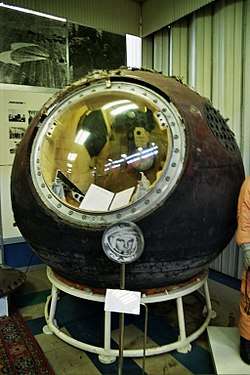1961 in spaceflight
 The Vostok 1 spacecraft, aboard which Yuri Gagarin became the first man to orbit the Earth on 12 April 1961 | |
| Orbital launches | |
|---|---|
| First | 31 January |
| Last | 22 December |
| Total | 50 |
| Successes | 28 |
| Failures | 20 |
| Partial failures | 2 |
| Catalogued | 36 |
| National firsts | |
| Spaceflight | |
| Space traveller | |
| Rockets | |
| Maiden flights | Atlas LV-3A Agena-B Kosmos-2I 63S1 Saturn I (suborbital test) |
| Retirements | Atlas LV-3A Agena-A Juno II |
| Crewed flights | |
| Orbital | 2 |
| Suborbital | 2 |
| Total travellers | 4 |
Deep Space Rendezvous
| Date (GMT) | Spacecraft | Event | Remarks |
|---|---|---|---|
| 19 May | Venera 1 | First flyby of Venus | Spacecraft was already non-functional as communication had been lost en route, closest approach: 100,000 kilometres (62,000 mi) |
Notable creations of orbital debris
| Date/Time (UTC) | Source object | Event type | Pieces tracked | Remarks |
|---|---|---|---|---|
| 29 June[1] | Thor-Able upper stage of Transit 4A navigation satellite | Rocket explosion | 294[1] | First explosion of a rocket stage in orbit creating hundreds of debris pieces |
Orbital launch summary
By country
 |
| |||||
| Orbital launch attempts by country in 1961 | ||||||
| Country | Launches | Successes | Failures | Partial failures |
Remarks |
|---|---|---|---|---|---|
| 9 | 5 | 4 | 0 | ||
| 41 | 23 | 16 | 2 |
By rocket
| Rocket | Country | Launches | Successes | Failures | Partial failures | Remarks |
|---|---|---|---|---|---|---|
| Atlas LV-3A Agena-A | 1 | 1 | 0 | 0 | Retired | |
| Atlas LV-3A Agena-B | 7 | 2 | 4 | 1 | Maiden flight | |
| Atlas LV-3B | 3 | 2 | 1 | 0 | First orbital launch | |
| RM-90 Blue Scout II | 1 | 0 | 1 | 0 | First orbital launch | |
| Juno II | 3 | 1 | 2 | 0 | Retired | |
| Kosmos-2I 63S1 | 2 | 0 | 2 | 0 | Maiden flight | |
| Molniya 8K78 | 2 | 1 | 1 | 0 | ||
| Scout X-1 | 3 | 1 | 2 | 0 | ||
| Thor DM-21 Ablestar | 3 | 2 | 0 | 1 | ||
| Thor DM-21 Agena-B | 17 | 11 | 6 | 0 | ||
| Thor DM-19 Delta | 3 | 3 | 0 | 0 | ||
| Vostok-K 8K72K | 5 | 4 | 1 | 0 |
By orbit
| Orbital regime | Launches | Achieved | Not Achieved | Accidentally Achieved | Remarks |
|---|---|---|---|---|---|
| Low Earth | 41 | 28 | 13 | 3 | |
| Medium Earth | 1 | 1 | 0 | 0 | |
| High Earth | 6 | 2 | 4 | 0 | Including Highly elliptical orbits |
| Heliocentric | 2 | 1 | 1 | 0 |
gollark: Only trusted users or those with the "cringe" role may view it.
gollark: Spirit:
gollark: Imagine having no headphone jack. Imagine no µSD slot. Imagine being pointlessly large for no reason. Imagine using a proprietary connector for charging etc. Imagine running an OS which forces all apps to be downloaded through a proprietary store.
gollark: They are NOT very good still. They're unrepairable, uncustomizable, encourage lock-in, and in many cases have stupid flaws like just not having adequate cooling.
gollark: Well, in a very real sense, Apple products bad.
References
Generic references:

- Bergin, Chris. "NASASpaceFlight.com".
- Clark, Stephen. "Spaceflight Now".
- Kelso, T.S. "Satellite Catalog (SATCAT)". CelesTrak.
- Krebs, Gunter. "Chronology of Space Launches".
- Kyle, Ed. "Space Launch Report".
- McDowell, Jonathan. "Jonathan's Space Report".
- Pietrobon, Steven. "Steven Pietrobon's Space Archive".
- Wade, Mark. "Encyclopedia Astronautica".
- Webb, Brian. "Southwest Space Archive".
- Zak, Anatoly. "Russian Space Web".
- "ISS Calendar". Spaceflight 101.
- "NSSDCA Master Catalog". NASA Space Science Data Coordinated Archive. NASA Goddard Space Flight Center.
- "Space Calendar". NASA Jet Propulsion Laboratory.
- "Space Information Center". JAXA.
- "Хроника освоения космоса" [Chronicle of space exploration]. CosmoWorld (in Russian).
Footnotes
- Orbital Debris: A Chronology (PDF). NASA JSC. January 1999. p. 18. Archived from the original (PDF) on 1 September 2000. Retrieved 13 February 2016.
Two hours after separating from the U.S. Transit 4-A satellite, its Able Star upper stage becomes the first known artificial object to break up unintentionally in space. The cause of the explosion is unknown. The event produces at least 294 trackable pieces, more than tripling the number of known satellites of Earth.
This article is issued from Wikipedia. The text is licensed under Creative Commons - Attribution - Sharealike. Additional terms may apply for the media files.